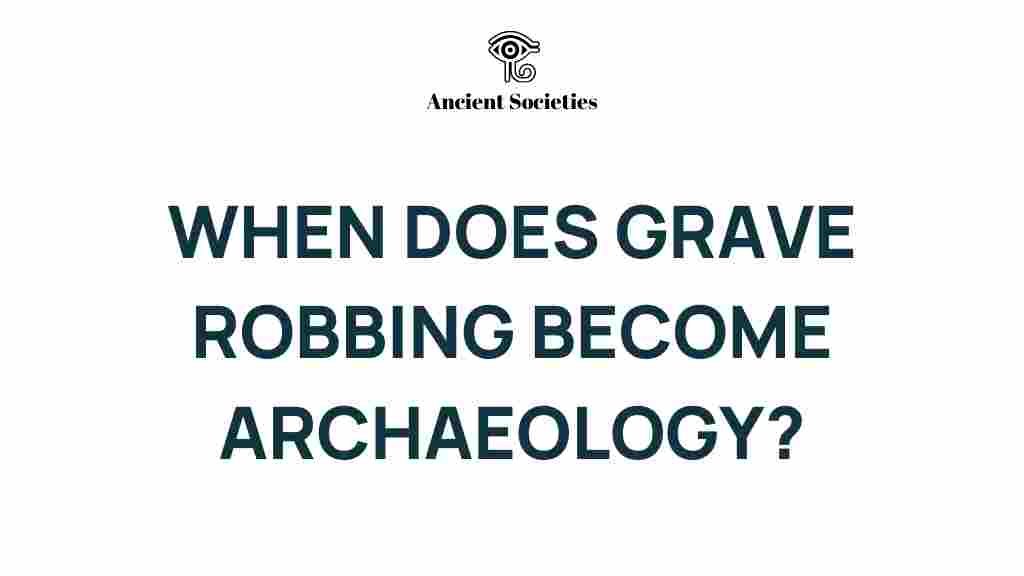When Does Grave Robbing Transform into Archaeology?
Grave robbing and archaeology: two terms often intertwined yet fundamentally different in purpose, methodology, and ethics. While grave robbing is typically associated with the illicit removal of artifacts and remains for personal gain, archaeology is a scientific discipline aimed at understanding and preserving human history. This article explores the fine line between these two practices, highlighting the ethical considerations, cultural heritage implications, and legal ramifications involved.
The Historical Context of Grave Robbing
Grave robbing has a long and complex history, dating back to ancient civilizations. Many cultures have engaged in this practice for various reasons, including:
- Treasure hunting: Seeking valuable items like gold, jewelry, and other artifacts.
- Religious beliefs: Some cultures believed that grave goods could be used in the afterlife.
- Scientific curiosity: Early “archaeologists” often engaged in grave robbing under the guise of exploration.
Throughout history, grave robbers have often exploited the deceased and their resting places, leading to significant losses of cultural heritage.
The Development of Archaeology
In contrast, archaeology has evolved as a scientific discipline focused on the systematic study of human history through excavation and analysis. Key developments in archaeology include:
- Field methods: Establishing standardized excavation practices to ensure careful recovery of artifacts.
- Contextual analysis: Understanding the historical context surrounding artifacts and remains.
- Preservation ethics: Emphasizing the importance of preserving cultural heritage for future generations.
Archaeologists strive to respect the cultural significance of sites and the individuals buried there, contrasting sharply with the opportunistic motives of grave robbing.
Ethics in Archaeology vs. Grave Robbing
The ethical implications of grave robbing versus archaeology are profound. Archaeologists adhere to a strict code of ethics that includes:
- Respect for the deceased: Treating human remains with dignity and care.
- Collaboration with communities: Engaging local communities in the excavation and interpretation of their heritage.
- Legal compliance: Following laws governing excavation and preservation.
In stark contrast, grave robbers operate outside the law and ethical norms, often disregarding the cultural significance of their actions. This disregard can lead to the irreversible loss of important historical data.
Legal Implications of Grave Robbing and Archaeological Practices
The legal framework surrounding archaeology and grave robbing varies significantly across regions. Key points to consider include:
- Ownership of artifacts: Many countries have laws that state artifacts found during excavations belong to the state or the local community.
- Protection of burial sites: Laws often exist to protect graves and archaeological sites from unauthorized excavation.
- Consequences of illegal activities: Grave robbing can lead to severe penalties, including fines and imprisonment.
Understanding these legal implications is crucial for anyone interested in archaeology or the protection of cultural heritage. For more information on legal aspects, you can visit this resource.
Excavation Practices: From Grave Robbing to Archaeology
To illustrate the transition from grave robbing to legitimate archaeology, consider the following step-by-step process:
Step 1: Site Identification
Legitimate archaeologists begin by identifying sites of historical significance, often through research and surveys. This contrasts with grave robbers, who typically seek out sites based on hearsay or rumors of treasure.
Step 2: Legal Permissions
Archaeologists must obtain the necessary permits and permissions from local authorities, ensuring that their work is legal and ethical. Grave robbers, however, often operate without any legal clearance.
Step 3: Excavation Techniques
Professional archaeologists employ meticulous excavation techniques to ensure that artifacts and remains are recovered in context. This careful approach preserves the integrity of the site. In contrast, grave robbing often involves hasty digging, resulting in damage and loss of historical information.
Step 4: Documentation
A crucial aspect of archaeology is thorough documentation of findings. Archaeologists record the location, depth, and condition of artifacts, contributing to a broader understanding of the historical context. Grave robbing lacks this level of documentation, focusing solely on the removal of valuable items.
Step 5: Analysis and Preservation
Once artifacts are excavated, archaeologists analyze them within their historical context. Preservation efforts are taken to protect the items for future generations. Conversely, grave robbers often destroy or sell artifacts without regard for their historical importance.
Preservation of Cultural Heritage
Preserving cultural heritage is a fundamental goal of archaeology. This involves:
- Conservation: Protecting artifacts and sites from decay and destruction.
- Education: Informing the public about the importance of cultural heritage and responsible stewardship.
- Community involvement: Engaging local communities in the preservation of their heritage.
Through these efforts, archaeologists contribute to a collective understanding of human history, whereas grave robbing often results in the loss of irreplaceable cultural narratives.
Troubleshooting Ethical Dilemmas in Archaeology
Archaeologists may encounter various ethical dilemmas during their work. Here are common challenges and potential solutions:
- Conflicts with local communities: It’s essential to engage with local populations, respecting their beliefs and traditions. Building trust and partnerships can lead to more successful outcomes.
- Balancing research and preservation: Sometimes, the pursuit of knowledge may conflict with the need to preserve a site. Prioritizing preservation can often lead to better long-term outcomes for cultural heritage.
- Dealing with looted artifacts: Archaeologists may come across artifacts that were previously looted. In such cases, they should consider ways to document and preserve these items while acknowledging their problematic history.
Conclusion
The distinction between grave robbing and archaeology is critical for understanding the ethics, cultural heritage implications, and legal frameworks surrounding the excavation of historical sites. While grave robbing is a destructive act that disregards human dignity and cultural significance, archaeology is a disciplined approach focused on preservation, education, and respect for the past.
By promoting ethical excavation practices, engaging with communities, and adhering to legal standards, archaeologists can ensure that they contribute positively to our understanding of history rather than detracting from it. As we navigate the complexities of our cultural heritage, it is vital to recognize the importance of preserving our past for future generations.
For further reading on the importance of ethical archaeology practices, visit this informative site.
This article is in the category Archaeology and created by AncientSocieties Team
